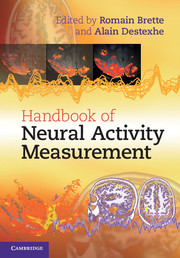Book contents
- Frontmatter
- Contents
- List of contributors
- 1 Introduction
- 2 Electrodes
- 3 Intracellular recording
- 4 Extracellular spikes and CSD
- 5 Local field potentials
- 6 EEG and MEG: forward modeling
- 7 MEG and EEG: source estimation
- 8 Intrinsic signal optical imaging
- 9 Voltage-sensitive dye imaging
- 10 Calcium imaging
- 11 Functional magnetic resonance imaging
- 12 Perspectives
- Plate section
- References
8 - Intrinsic signal optical imaging
Published online by Cambridge University Press: 05 October 2012
- Frontmatter
- Contents
- List of contributors
- 1 Introduction
- 2 Electrodes
- 3 Intracellular recording
- 4 Extracellular spikes and CSD
- 5 Local field potentials
- 6 EEG and MEG: forward modeling
- 7 MEG and EEG: source estimation
- 8 Intrinsic signal optical imaging
- 9 Voltage-sensitive dye imaging
- 10 Calcium imaging
- 11 Functional magnetic resonance imaging
- 12 Perspectives
- Plate section
- References
Summary
Introduction
The most popular technique for investigating the functional organization and plasticity of the cortex involves the use of a single microelectrode. It offers the advantage of recording action potentials and subthreshold activity directly from cortical neurons with high spatial (point) and temporal (millisecond) resolution sufficient to follow real-time changes in neuronal activity at any location along a volume of cortex, with the disadvantage that recordings are invasive to the cortex. In order to assess the functional representation of a sensory organ (e.g. a finger, a whisker), neurons are recorded from different cortical locations and the functional representation of the organ is then defined as the cortical region containing neurons responsive to stimulation of that organ (i.e. neurons that have receptive fields localized at the sensory organ). A change in the spatial distribution of neurons responsive to a given sensory organ and/or in their amplitude of response is typically taken as evidence for plasticity in the functional representation of that sensory organ (Merzenich et al., 1984). As a cortical functional representation could comprise thousands to millions of neurons distributed over a volume of cortex, the use of a single microelectrode to map a functional representation and its plasticity requires many recordings across a large cortical region, recordings that can only be obtained in a serial fashion and require many hours to complete, thus the animal is typically anesthetized.
- Type
- Chapter
- Information
- Handbook of Neural Activity Measurement , pp. 287 - 326Publisher: Cambridge University PressPrint publication year: 2012
References
- 2
- Cited by

